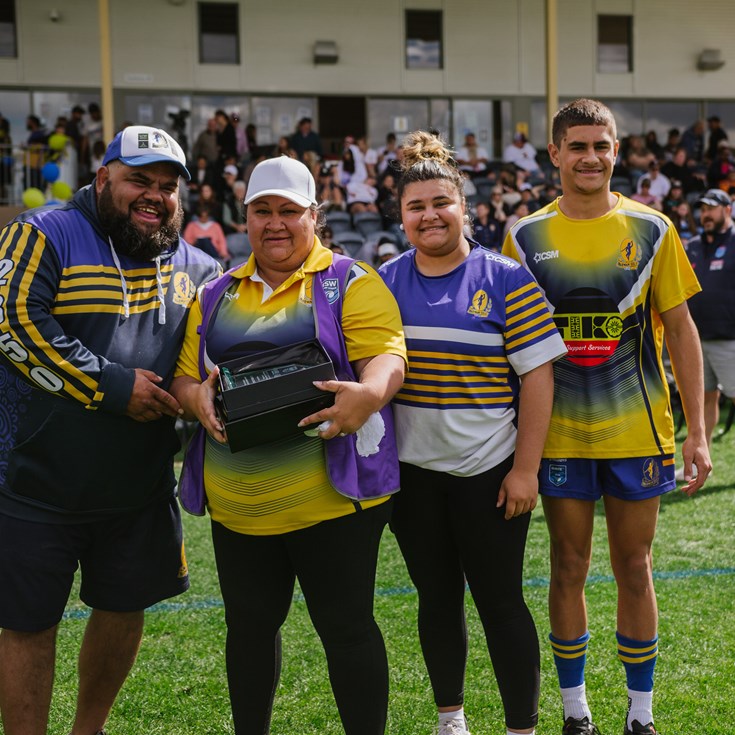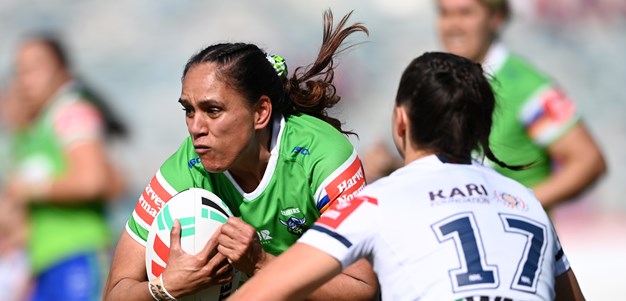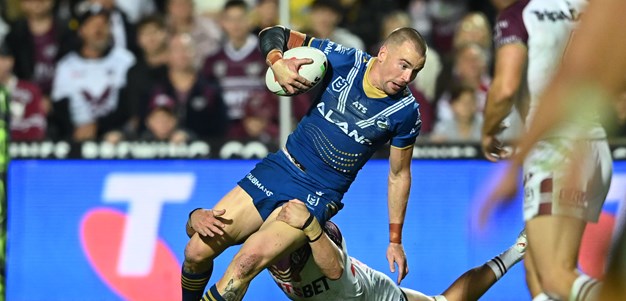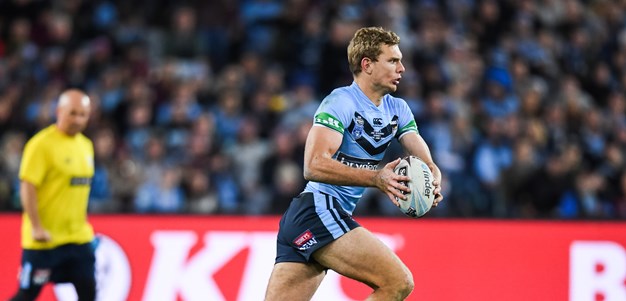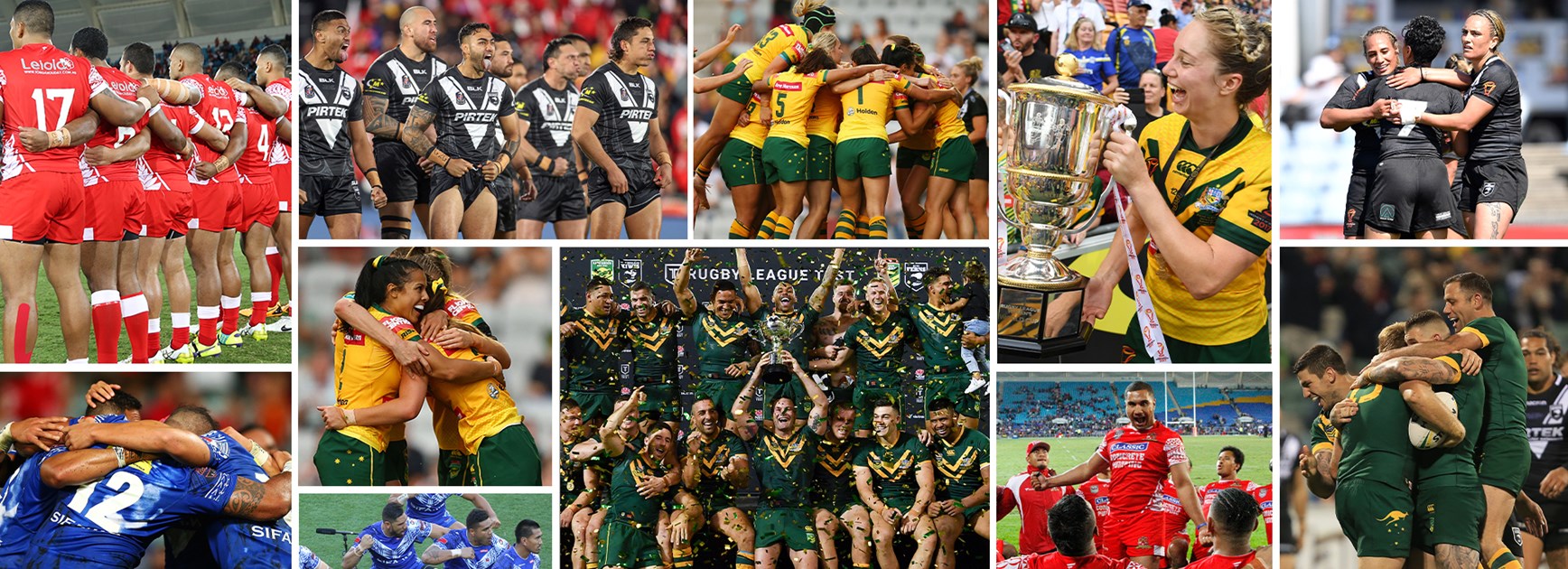
The 2021 Rugby League World Cup has arrived a year later than first planned but comes at just the right time for the game to celebrate a triumphant return to the global stage.
In the wake of the COVID-19 pandemic which forced the tournament to be postponed for 12 months, the greatest show on turf brings together men’s, women’s and wheelchair athletes for five weeks of sensational action starting on October 16 when host nation England face Samoa at St James’ Park and culminating with the Final at Old Trafford on November 20.
What began in 1954 in France as a pipedream has evolved into a showpiece event which has been won 11 times by defending champions Australia, while Great Britain took home the prize three times and New Zealand once, with a famous victory over the Kangaroos in Brisbane in 2008.
To the winner goes the Paul Barriere Trophy, named in honour of the French Rugby League President of the 1940s and 50s who was instrumental in making the concept a reality in 1954, when France, Great Britain, New Zealand and Australia played a round robin tournament with the top two teams progressing to the first ever World Cup Final.
That honour went to host nation France, captained by legendary fullback Puig Aubert, and Great Britain, who would go on to win the final 16-12 at Parc des Princes.
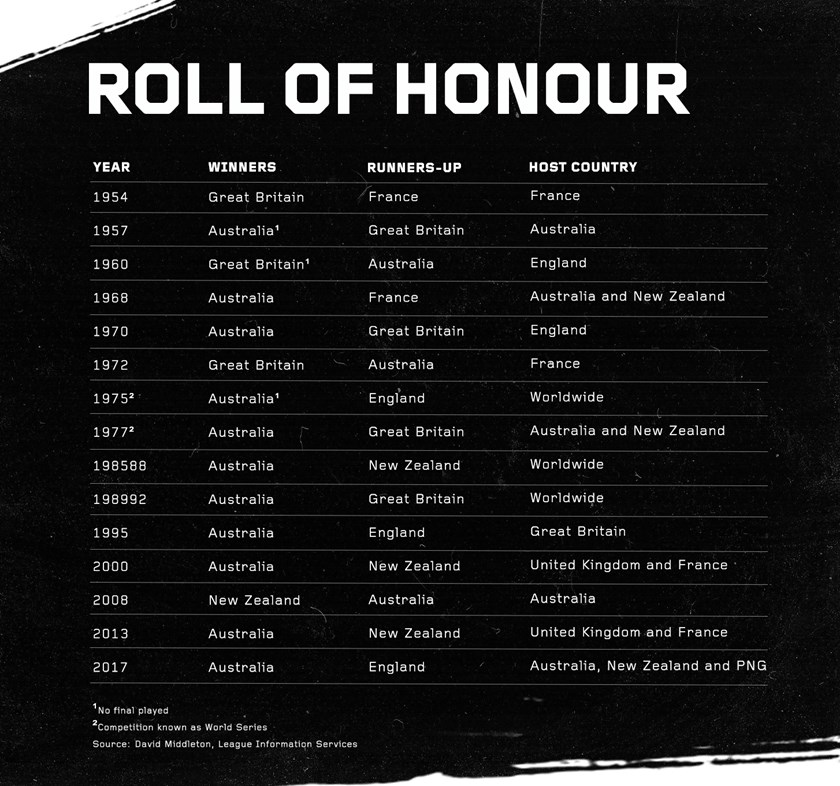
Three years later the Australian side captain-coached by Newtown’s Dick Poole would claim their first title by virtue of three convincing victories in the pool stage with no final being played.
Boasting such luminaries as Norm Provan, Keith Barnes, Keith Holman and Harry Wells, the Aussies thrilled massive crowds at the Sydney Cricket Ground and the Gabba to dominate the Kiwis, French and British.
The 1960 World Cup again comprised of only pool games, with host nation Great Britain sweeping the pool under Eric Ashton’s leadership to win their second World Cup.
In the ensuing six decades the tournament has been dominated by Australia with 10 titles, while Great Britain’s only other success came in France in 1972 and the Kiwis finally savoured the ultimate glory at their 13th attempt, beating the Kangaroos 34-20 at Suncorp Stadium in a result that shook the league world.
Try as they might, New Zealand had never beaten their Trans-Tasman rival in a single tournament fixture, let alone a final, but with 50,559 in the house and millions more watching on television, the Stephen Kearney-coached Kiwis produced an unbelievable comeback from 10-0 down in the first 20 minutes to break their drought in style.
With the game in the balance midway through the second half it was a case of ‘cometh the hour mark, cometh the man’ as Benji Marshall scored the most important try in the proud history of New Zealand rugby league.
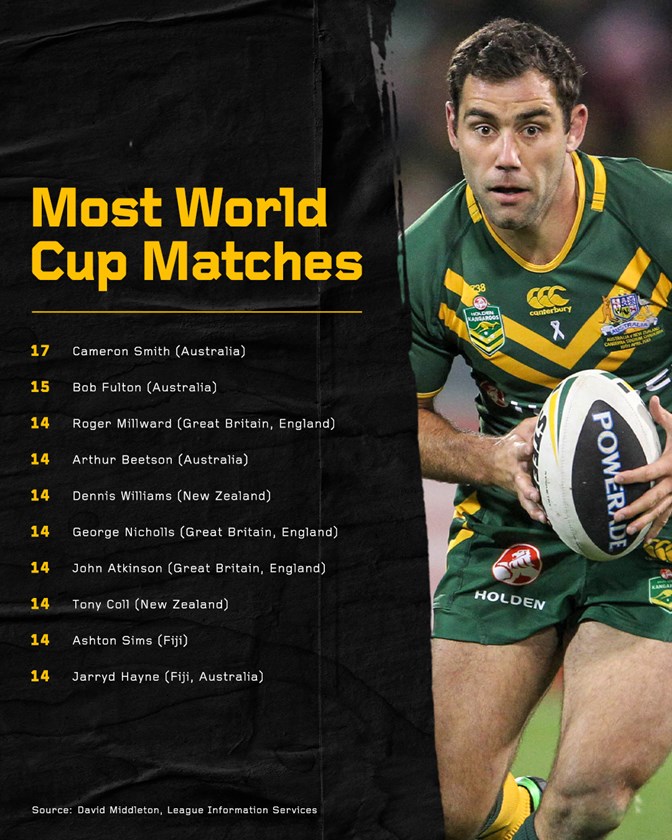
Kangaroos fullback Billy Slater had retrieved a kick near his own goal line and tried to get around the outside of Kiwi winger Manu Vatuvei, who shoved the Aussie No.1 towards the sideline.
Rather than take the ball into touch, Slater made the fateful decision to toss the ball back infield, hoping to find a team-mate. Instead it was Marshall on the spot to pounce on the loose ball and plant it down for a try that gave New Zealand a 22-16 lead.
Greg Inglis scored soon after to pull it back to 22-20 before a penalty try to Lance Hohai which Marshall converted in the 70th minute gave the Kiwis an eight-point advantage and the Cup was theirs, before a late Adam Blair try iced the cake.
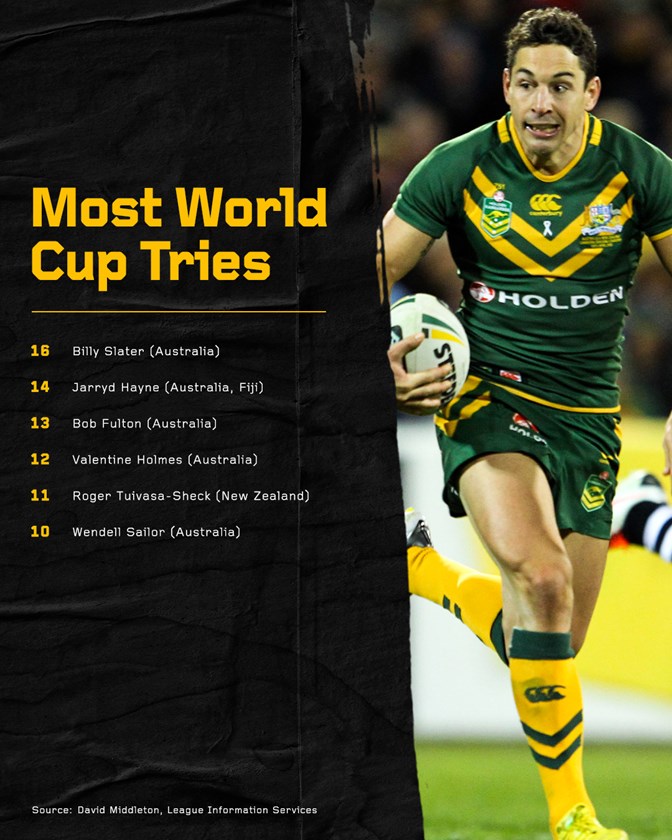
The Kangaroos hit back in style four years later in England, racking up 126-0 in their quarter-final and semi-final demolition of the USA and Fiji before dismantling New Zealand 34-2 in the Final at Old Trafford thanks to doubles from Slater and Brett Morris.
In 2017 it was Australia again standing tall, this time on home soil, but not before a hell of a scare from England in the Final, which was decided by a lone try to Boyd Cordner early in the match.
And now, after a five-year wait, the Kangaroos look to defend their title against old foes England and New Zealand, and the rising forces of Tonga and Samoa.
With so much history and so much to play for, it promises to be an epic five weeks as bragging rights go on the line at World Cup 2021.
Women's World Cup
The inaugural women’s World Cup was staged in England in 2000, with Kiwi Ferns legend Trish Hina leading New Zealand to a 26-4 over Great Britain & Ireland in the Final in Warrington.
Just three teams had taken part in the tournament, with Karyn Murphy’s Australians losing both their pool matches to miss out on the Final.
Three years later the tournament expanded to nine teams, with the original trio joined by Cook Islands, NZ Maori, Samoa, Tonga, Tokelua and Niue.
Staged in Auckland, the 2003 World Cup proved to be a triumph for the host nation, with the Kiwi Ferns facing the Maori in the Final at North Harbour Stadium.
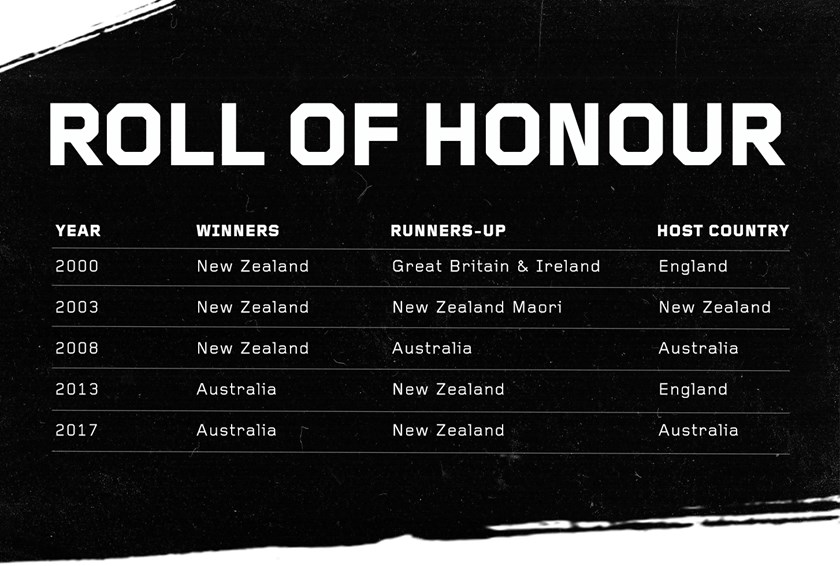
The Kiwi Ferns proved far too strong in a 58-0 triumph, with 22-year-old Honey Hireme scoring a double to take her tally for the tournament to 10.
Hireme holds the record for most tries scored in a World Cup match with six against Cook Islands in 2017, an honour she shares with fellow Kiwi Fuarosa Time, who crossed six times Tokelau at North Harbour Stadium in 2003.
Come 2008 and the Kiwis defended their crown with a 34-0 win over Australia at Suncorp Stadium before the Jillaroos claimed their maiden title in 2013 in England.
Appearing at her third World Cup, Murphy captained Australia to a 22-12 win over New Zealand in the Final, with Jennie Sue Hoepper, Tarah Westera, Sam Hammond and Heather Ballinger scoring tries.
“Australia and England were fairly similar, we'd always have close games against each other, but New Zealand was just virtually impossible to beat, let alone comfortably. They were too big, too fast, too strong for us,” Murphy told NRL.com in 2020.
“It was so hard. We had a win in Penrith back in 1999 – it was one win but from then on we got beaten and beaten well for the rest of my time playing. It was hard to take.
Their playmaker, Trish Hina, was so strong and talented, she had an amazing step on her – she could cut out half the field with her pass. When she retired that's one of a few reasons I thought we were a big chance in the World Cup. We had a really good squad and had the financial backing for the first time. I just had that feeling.”
Australia made it back-to-back World Cups in 2017 under the guidance of current coach Brad Donald and skipper Renae Kunst, with Ali Brigginshaw voted the player of the Final.
In a significant breakthrough for the women’s game it was the first Final to be played as a double-header with the men's Final.
A new-look Jillaroos squad featuring only five players - Kezie Apps, Sam Bremner, Isabelle Kelly, Simaima Taufa and Brigginshaw – will kick off their title defence against Cook Islands on November 3.
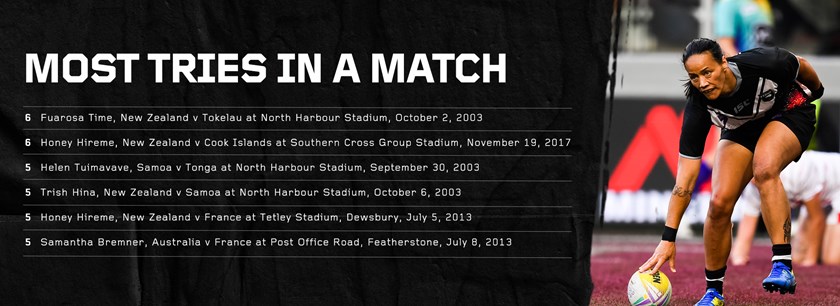
Their biggest threat will once again come from three-time champions New Zealand, who have won 22 of their 24 World Cup matches since 2000 at a stunning success rate of 91.7 per cent.
Led by 2022 NRLW Dally M medallist Raecene McGregor and Brisbane props Annetta-Claudia Nu’uausala, Amber-Paris Hall and Brianna Clark, the Kiwi Ferns have the weapons to again go all the way to the Final at Old Trafford while big things are also expected of host nation England.
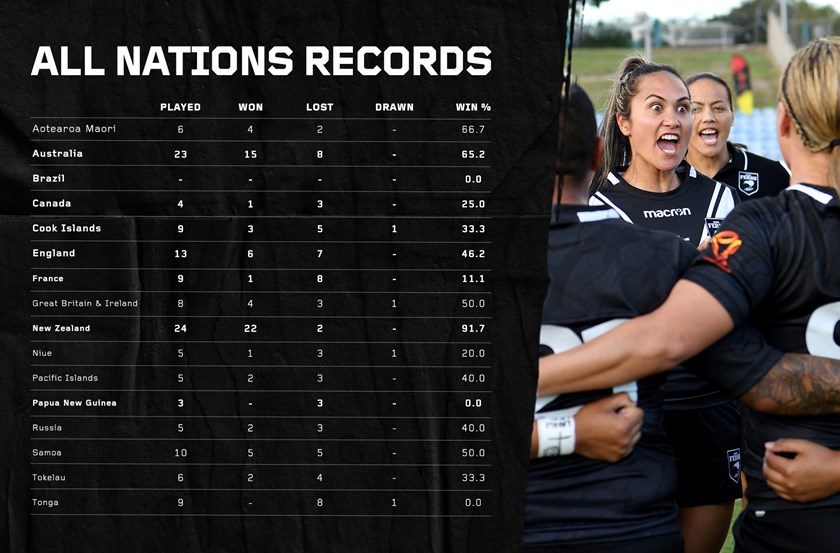
Wheelchair World Cup
For the first time in the history of the wheelchair competition it will be part of the Rugby League World Cup main event.
Australia will feature in Group A alongside England, Ireland and Spain while world No.1 France, Scotland, USA and Wales make up Group B.
The Wheelaroos open their campaign with a blockbuster clash against England at London’s Copper Box Arena on November 3, with Craig and Corey Cannane set to make history as the first father and son to represent Australia together at a World Cup.
The father-and-son pairing have been key members of the Dragons side that won four consecutive NSW Wheelchair Rugby League grand finals before losing this year’s decider and they have also played State of Origin together.
Corey is taking part in his first World Cup while dad Craig was part of the Australian team in 2017 when France collected the spoils.
The past three Wheelchair Rugby League World Cups were part of the ‘Festival of World Cups’ in which they competed alongside the Universities, Police and Armed Forces tournaments but the Wheelchair tournament takes centre stage this time around.
It continues the rapid development of the Wheelchair game since four teams competed in the inaugural World Cup in 2008, with England taking the spoils 44-12 over Australia in the Final.
The 2013 Wheelchair Rugby League World Cup was held in Gillingham, England and in 2017 the tournament was held in the south of France, with the hosts outlasting England 38-34 in a thrilling Final.
Wheelchair rugby league is a fast, entertaining, and highly physical branch of the game.
Match Highlights: Wheelchair State of Origin, 2022
There are five players per side on court at a time, with each team allowed two AB (able-bodied) players making wheelchair rugby league one of the most inclusive sports around.
It’s two 40-minute halves, and the same points scoring as the running game. The ‘field of play’ is 50-metres in length and 25-metres wide, across three indoor basketball courts.
Rules are similar – players must pass backwards, possession changes after six tackles. A ‘tackle’ is made by ripping off the Velcro shoulder tag of an opposition player,
Kicks downfield, conversions, penalties and field goals are hand-punted. A play-the-ball is made by tapping the football on the ground before passing.

